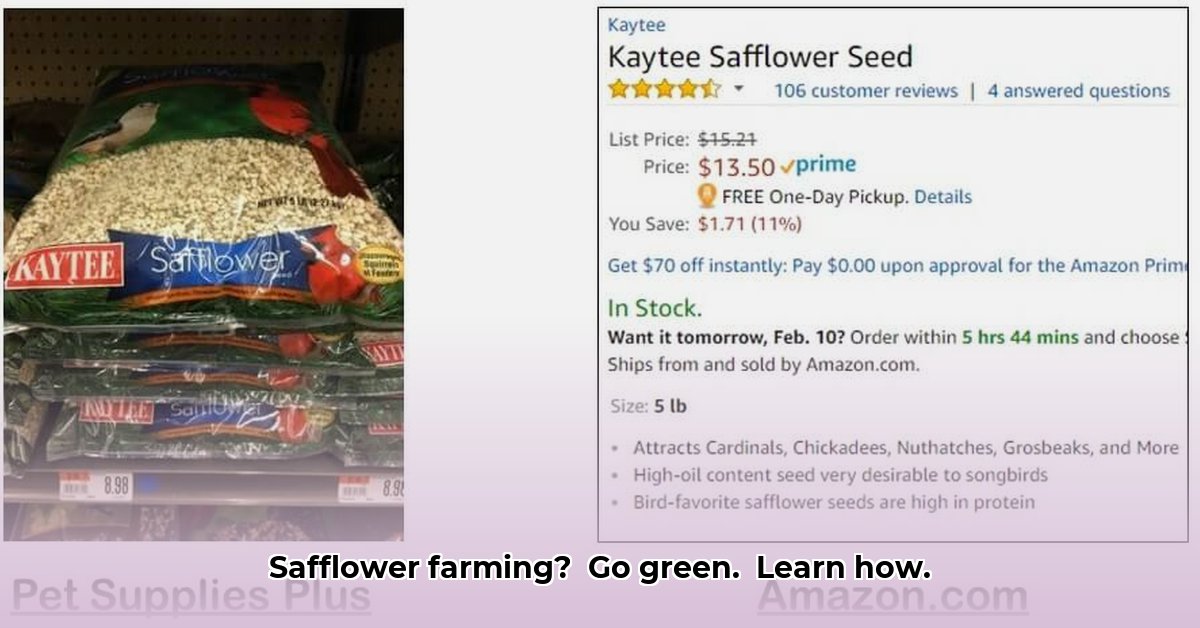
Choosing the Right Seeds: The Foundation of Sustainable Farming
Selecting the right safflower seeds is paramount for environmentally friendly farming. Opt for varieties known for disease and pest resistance, minimizing (or eliminating) the need for harmful pesticides that can negatively impact beneficial insects and wildlife. Consider the origin of your seeds; prioritize suppliers committed to sustainable practices. Ask about their fertilizer use, water conservation methods, and overall approach to environmental stewardship. Remember, your seeds are the foundation of your crop and a healthy environment. Don't you want to start with the best possible foundation? For more on sustainable farming equipment, check out this resource.
Optimizing Tractor Use: Efficiency is Key
Efficient tractor use is essential for sustainable farming. Minimize soil disturbance by using minimal tillage techniques (reducing plowing) which preserve soil structure, reduce erosion, and improve soil health, while simultaneously saving fuel. Precision farming technology, including GPS-guided equipment, allows for targeted fertilizer application, minimizing waste and maximizing efficiency. Investing in fuel-efficient newer tractor models, while initially expensive, provides long-term savings and reduces the environmental impact of your operation. Isn't it a worthwhile investment in the long run?
Water Conservation: Making Every Drop Count
While safflower is drought-tolerant, responsible water management remains crucial, especially in arid regions. Drip irrigation systems deliver water directly to plant roots, minimizing evaporation and runoff, and ensuring efficient hydration. Prioritize good soil drainage to prevent waterlogging, which can damage roots and reduce yields. Water conservation is crucial; how much water can you save precisely through effective irrigation techniques?
Smart Pest Management: Working with Nature
Integrated pest management (IPM) is a superior alternative to heavy pesticide use. IPM involves monitoring pest populations, utilizing natural predators (beneficial insects), and employing biopesticides (derived from natural sources). Healthy soil fosters healthier plants, better equipped to withstand pest infestations. A balanced approach to pest control is better for both your plants and the environment. What percentage of pest problems can IPM successfully address?
Sustainable Harvesting and Transportation
Sustainable practices extend beyond planting and growing. Harvest at the optimal time to minimize crop losses and maximize seed quality. Prioritize transportation methods that minimize fuel consumption and greenhouse gas emissions, such as using local processing facilities to reduce travel distances. Every step counts! How can you optimize your transportation strategy for maximum efficiency and minimal ecological impact?
Soil Health and Nutrient Management: Long-Term Sustainability
Healthy soil is the cornerstone of sustainable agriculture. Crop rotation maintains soil fertility by varying nutrient demands. Incorporating legumes adds nitrogen, reducing reliance on synthetic fertilizers. Cover crops protect against erosion and improve soil structure. These methods build long-term soil health and reduce soil degradation. What is the long-term impact of neglecting soil health?
Packaging and Distribution: Closing the Loop
Sustainability extends to packaging and distribution. Choose biodegradable or recyclable packaging materials to reduce your environmental footprint. Encourage suppliers to adopt sustainable packaging. Every little step helps to maximize your commitment to sustainability—how can you further minimize the environmental effects of your supply chain?
How to Choose Sustainably Sourced Safflower Seeds for Bird Feeding
Choosing sustainably sourced safflower seeds for your bird feeders directly benefits both birds and the environment. Look for certifications like organic or fair trade, indicating responsible farming. Buying local reduces transportation emissions. Opt for birdseed mixes that exclude corn, a low-nutrient filler often found in birdseed. Consider shelled ("no-mess") seeds to minimize wasted seeds and leftover husks.
“Supporting local producers is not only beneficial for the environment but also revitalizes our local economies," says Dr. Emily Carter, Professor of Ornithology at Cornell University. "When we buy locally, we contribute to the economic prosperity of our communities, fostering a sense of connection between people and businesses."
Remember, even small choices have a significant impact on the health of the planet and the well-being of wildlife. By prioritizing sustainability in your bird feeding practices, you contribute to a wholesome ecosystem, enriching the lives of birds and nurturing our shared environment. Avian Bliss even advocates for corn-free wild birdseed. What could be a better way to show your love for birds than to feed them sustainably?